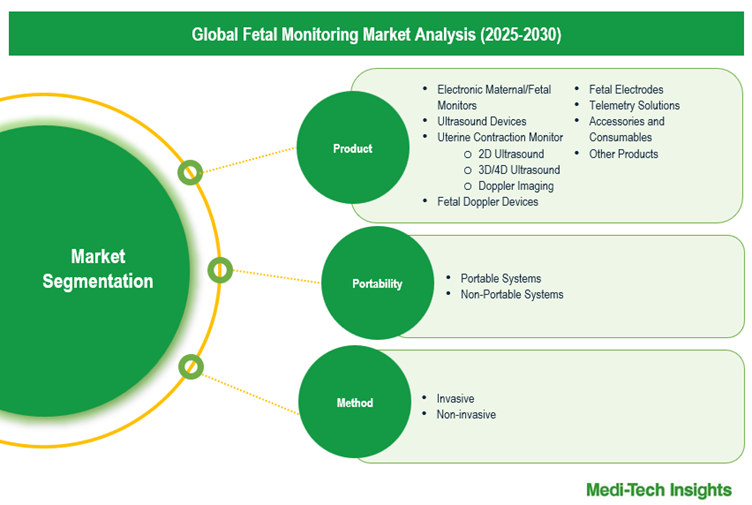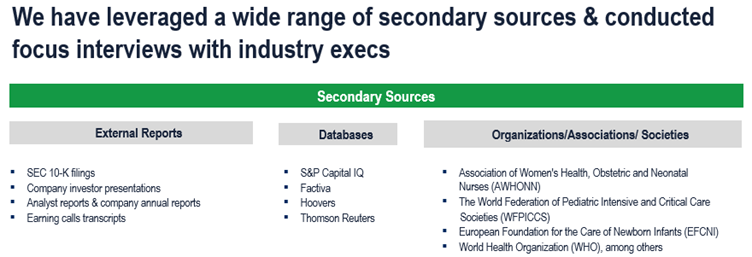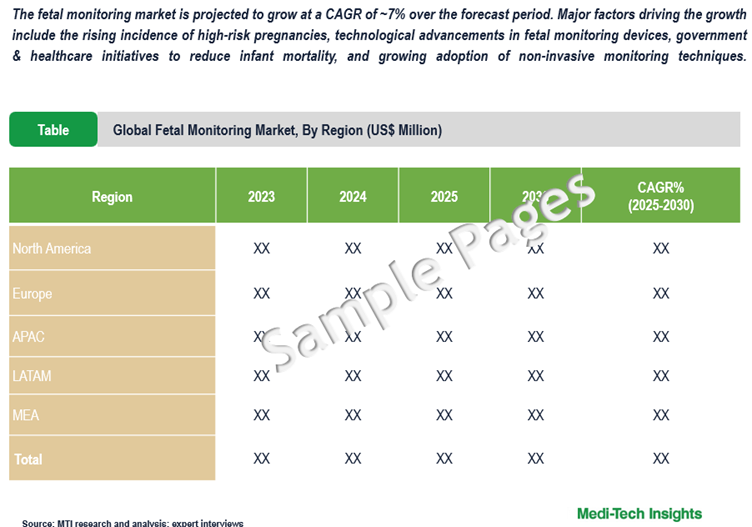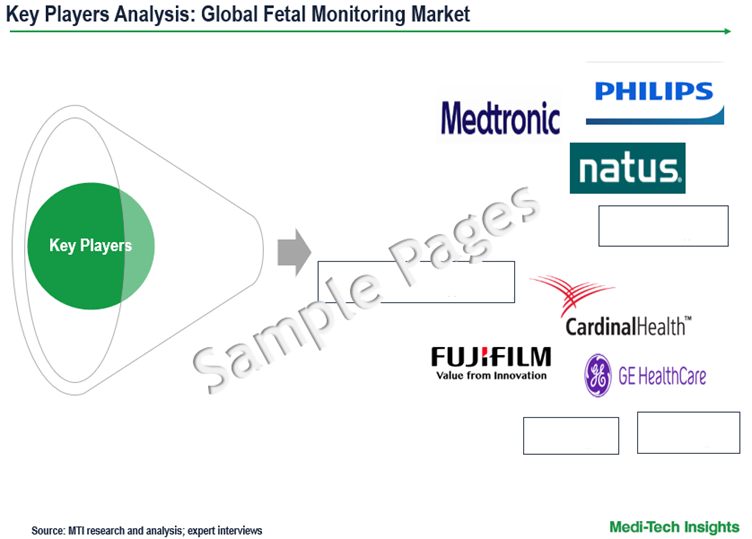
Fetal Monitoring Market Size Report Segmented by Product (Ultrasound Devices, Fetal Electrodes, Fetal Dopplers Devices), Portability (Portable, Non-Portable), Method (Invasive, Non-invasive), Application (Antepartum, Intrapartum) & Forecast to 2030
The fetal monitoring market is projected to grow at a CAGR of ~7% over the forecast period. Major factors driving the growth include the rising incidence of high-risk pregnancies, technological advancements in fetal monitoring devices, government initiatives to reduce infant mortality rates, rising birth rates in emerging markets, and the growing adoption of non-invasive monitoring techniques. To learn more about the research report, download a sample report.
Report Overview
Fetal monitoring involves the continuous or periodic observation of a fetus's heart rate, movement, and overall health throughout pregnancy and labor. It helps healthcare professionals evaluate fetal well-being, detect signs of distress, and ensure a safe delivery. Fetal heart rate monitoring identifies variations in the baby's heartbeat, including increase, decrease, and overall variability. The normal fetal heart rate typically ranges from 110 to 160 beats per minute but may fluctuate in response to conditions within the uterus. An abnormal heart rate or pattern could indicate inadequate oxygen supply or other complications, potentially requiring an emergency cesarean (C-section) delivery.

To learn more about the research report, download a sample report.
The rising incidence of high-risk pregnancies increases fetal monitoring adoption
High-risk pregnancies involve conditions that may endanger the health of the mother, fetus, or newborn, requiring continuous monitoring to ensure their well-being. These risks can stem from factors such as chronic diseases, multiple gestation, previous pregnancy complications, or new obstetric and non-obstetric conditions that develop during pregnancy. Medical conditions like diabetes, hypertension, thyroid disorders, psychiatric disorders, genetic factors, and past pregnancy complications necessitate the use of advanced fetal monitoring technologies to detect potential issues early and facilitate timely medical intervention. Hypertension during pregnancy, for instance, has long been recognized as a major risk factor that can negatively impact both the placenta and fetus, potentially leading to serious maternal and fetal complications. Consequently, high-risk pregnancies require intensive monitoring, including frequent prenatal visits, blood tests, ultrasonography, and specialized fetal monitoring techniques to manage complications effectively. With the global rise in high-risk pregnancies, the demand for accurate, efficient, and accessible fetal monitoring systems continues to grow, driving advancements in maternal-fetal healthcare.

To learn more about the research report, download a sample report.
Technological advancements in fetal monitoring devices drive market growth
Fetal monitoring plays a vital role in obstetric care, ensuring the safe delivery of a healthy baby. Traditionally, it relied on intermittent auscultation using a fetal stethoscope or Pinard horn. However, advancements in medical technology have led to the development of sophisticated, non-invasive monitoring techniques, enabling continuous fetal assessment. These innovations have significantly improved obstetric outcomes by allowing healthcare providers to identify potential complications early and take preventive measures.
One of the most notable advancements is electronic fetal monitoring (EFM), which has become the standard of care in many clinical settings. EFM enables continuous fetal heart rate (FHR) monitoring, allowing early detection of distress and reducing the risks of neonatal seizures, asphyxia, and cerebral palsy. Additionally, fetal pulse oximetry (FPO) enhances fetal monitoring by measuring oxygen saturation in fetal blood, providing a more comprehensive assessment when used alongside EFM. Emerging technologies such as fetal electroencephalography (fEEG) are also being developed, offering insights into fetal brain activity and helping detect neurological abnormalities early.
Moreover, non-invasive fetal monitoring solutions, including advanced Doppler ultrasound and AI-powered predictive analytics, are revolutionizing maternal-fetal healthcare by improving diagnostic accuracy while reducing the need for invasive procedures. With healthcare systems increasingly prioritizing maternal and fetal health, the demand for smart, AI-integrated, and remote fetal monitoring technologies continues to rise, driving market growth and innovation.
Competitive Landscape Analysis
The global fetal monitoring market is marked by the presence of established and emerging market players such as Becton, Dickinson, and Company; Biolight Medical; Cardinal Health; DOTO Health; EDAN Instrument; FUJIFILM Holdings Corporation; GE Healthcare; Huntleigh Healthcare (Arjo); Koninklijke Philips; Medtronic; Natus Medical Incorporated; Siemens AG; Neoventa Medical AB; MedGyn Products, Inc; and Mindray Medical; among others. Some of the key strategies adopted by market players include new product development, strategic partnerships and collaborations, and investments.
Report Scope
|
Report Scope |
Details |
|
Base Year Considered |
2024 |
|
Historical Data |
2023 - 2024 |
|
Forecast Period |
2025 - 2030 |
|
Growth Rate |
~7% |
|
Market Drivers |
|
|
Attractive Opportunities |
|
|
Segment Scope |
Product, Portability, Method, Application, and End User |
|
Regional Scope |
|
|
Key Companies Mapped |
Becton, Dickinson, and Company; Biolight Medical; Cardinal Health; DOTO Health; EDAN Instrument; FUJIFILM Holdings Corporation; GE Healthcare; Huntleigh Healthcare (Arjo); Koninklijke Philips; Medtronic; Natus Medical Incorporated; Siemens AG; Neoventa Medical AB; MedGyn Products, Inc; and Mindray Medical |
|
Report Highlights |
Market Size & Forecast, Growth Drivers & Restraints, Trends, Competitive Analysis |
Market Segmentation
This report by Medi-Tech Insights provides the size of the global fetal monitoring market at the regional and country levels from 2023 to 2030. The report further segments the market based on product, portability, method, application, and end user.
- Market Size & Forecast (2023-2030), By Product, USD Million
- Electronic Maternal/Fetal Monitors
- Ultrasound Devices
- Uterine Contraction Monitor
- 2D Ultrasound
- 3D/4D Ultrasound
- Doppler Imaging
- Fetal Doppler Devices
- Fetal Electrodes
- Telemetry Solutions
- Accessories and Consumables
- Other Products
- Market Size & Forecast (2023-2030), By Portability, USD Million
- Portable Systems
- Non-Portable Systems
- Market Size & Forecast (2023-2030), By Method, USD Million
- Invasive
- Non-invasive
- Market Size & Forecast (2023-2030), By Application, USD Million
- Antepartum
- Intrapartum
- Market Size & Forecast (2023-2030), By End User, USD Million
- Obstetrics & Gynaecology Clinics
- Hospitals
- Home Care Settings
- Market Size & Forecast (2023-2030), By Region, USD Million
- North America
- US
- Canada
- Europe
- UK
- Germany
- France
- Italy
- Spain
- Rest of Europe
- Asia Pacific
- China
- India
- Japan
- Rest of Asia Pacific
- Latin America
- Middle East & Africa
- North America
Key Strategic Questions Addressed
- What is the market size & forecast of the fetal monitoring market?
- What are the historical, present, and forecasted market shares and growth rates of various segments and sub-segments of the fetal monitoring market?
- What are the key trends defining the market?
- What are the major factors impacting the market?
- What are the opportunities prevailing in the market?
- Which region has the highest share in the global market? Which region is expected to witness the highest growth rate in the next 5 years?
- Who are the major players operating in the market?
- What are the key strategies adopted by players?
- Introduction
- Introduction
- Market Scope
- Market Definition
- Segments Covered
- Regional Segmentation
- Research Timeframe
- Currency Considered
- Study Limitations
- Stakeholders
- List of Abbreviations
- Key Conferences and Events (2025-2026)
- Research Methodology
- Secondary Research
- Primary Research
- Market Estimation
- Bottom-Up Approach
- Top-Down Approach
- Market Forecasting
- Executive Summary
- Fetal Monitoring Market Snapshot (2025-2030)
- Segment Overview
- Regional Snapshot
- Competitive Insights
- Market Overview
- Market Dynamics
- Drivers
- Rising incidence of high-risk pregnancies
- Technological advancements in fetal monitoring devices
- Government initiatives to reduce infant mortality rates
- Rising birth rates in emerging markets
- Growing adoption of non-invasive monitoring techniques
- Restraints
- High costs of fetal monitoring devices
- Stringent regulatory requirements
- Resistance to the adoption of new technologies
- Opportunities
- Technological advancements in ultrasound and high-resolution imaging
- Rising adoption of cloud-based & data analytics solutions
- Growing demand for AI & IoT-enabled monitoring
- Drivers
- Market Dynamics
-
-
- Key Market Trends
- Growing adoption of wireless & portable fetal monitors
- Increased usage of AI-powered predictive analytics in fetal monitoring
- Rising preference for non-invasive monitoring solutions
- Key Market Trends
- Unmet Market Needs
- Industry Speaks
-
- Global Fetal Monitoring Market Size & Forecast (2023-2030), By Product, USD Million
- Introduction
- Electronic Maternal/Fetal Monitors
- Ultrasound Devices
- Uterine Contraction Monitor
- 2D Ultrasound
- 3D/4D Ultrasound
- Doppler Imaging
- Fetal Doppler Devices
- Fetal Electrodes
- Telemetry Solutions
- Accessories and Consumables
- Other Products
- Global Fetal Monitoring Market Size & Forecast (2023-2030), By Portability, USD Million
- Introduction
- Portable Systems
- Non-Portable Systems
- Global Fetal Monitoring Market Size & Forecast (2023-2030), By Method, USD Million
- Introduction
- Invasive
- Non-invasive
- Global Fetal Monitoring Market Size & Forecast (2023-2030), By Application, USD Million
- Introduction
- Antepartum
- Intrapartum
- Global Fetal Monitoring Market Size & Forecast (2023-2030), By End User, USD Million
- Introduction
- Obstetrics & Gynaecology Clinics
- Hospitals
- Home Care Settings
- Global Fetal Monitoring Market Size & Forecast (2023-2030), By Region, USD Million
- Introduction
- North America Fetal Monitoring Market Size & Forecast (2023-2030), By Country, USD Million
- US
- Market Size & Forecast, By Product (USD Million)
- Market Size & Forecast, By Portability (USD Million)
- Market Size & Forecast, By Method (USD Million)
- Market Size & Forecast, By Application (USD Million)
- Market Size & Forecast, By End User (USD Million)
- Canada
- Market Size & Forecast, By Product (USD Million)
- Market Size & Forecast, By Portability (USD Million)
- Market Size & Forecast, By Method (USD Million)
- Market Size & Forecast, By Application (USD Million)
- Market Size & Forecast, By End User (USD Million)
- US
- Europe Fetal Monitoring Market Size & Forecast (2023-2030), By Country, USD Million
- UK
- Market Size & Forecast, By Product (USD Million)
- Market Size & Forecast, By Portability (USD Million)
- Market Size & Forecast, By Method (USD Million)
- Market Size & Forecast, By Application (USD Million)
- Market Size & Forecast, By End User (USD Million)
- Germany
- Market Size & Forecast, By Product (USD Million)
- Market Size & Forecast, By Portability (USD Million)
- Market Size & Forecast, By Method (USD Million)
- Market Size & Forecast, By Application (USD Million)
- Market Size & Forecast, By End User (USD Million)
- France
- Market Size & Forecast, By Product (USD Million)
- Market Size & Forecast, By Portability (USD Million)
- Market Size & Forecast, By Method (USD Million)
- Market Size & Forecast, By Application (USD Million)
- Market Size & Forecast, By End User (USD Million)
- Italy
- Market Size & Forecast, By Product (USD Million)
- Market Size & Forecast, By Portability (USD Million)
- Market Size & Forecast, By Method (USD Million)
- Market Size & Forecast, By Application (USD Million)
- Market Size & Forecast, By End User (USD Million)
- Spain
- Market Size & Forecast, By Product (USD Million)
- Market Size & Forecast, By Portability (USD Million)
- Market Size & Forecast, By Method (USD Million)
- Market Size & Forecast, By Application (USD Million)
- Market Size & Forecast, By End User (USD Million)
- Rest of Europe
- Market Size & Forecast, By Product (USD Million)
- Market Size & Forecast, By Portability (USD Million)
- Market Size & Forecast, By Method (USD Million)
- Market Size & Forecast, By Application (USD Million)
- Market Size & Forecast, By End User (USD Million)
- UK
- Asia Pacific (APAC) Fetal Monitoring Market Size & Forecast (2023-2030), By Country, USD Million
- China
- Market Size & Forecast, By Product (USD Million)
- Market Size & Forecast, By Portability (USD Million)
- Market Size & Forecast, By Method (USD Million)
- Market Size & Forecast, By Application (USD Million)
- Market Size & Forecast, By End User (USD Million)
- Japan
- Market Size & Forecast, By Product (USD Million)
- Market Size & Forecast, By Portability (USD Million)
- Market Size & Forecast, By Method (USD Million)
- Market Size & Forecast, By Application (USD Million)
- Market Size & Forecast, By End User (USD Million)
- India
- Market Size & Forecast, By Product (USD Million)
- Market Size & Forecast, By Portability (USD Million)
- Market Size & Forecast, By Method (USD Million)
- Market Size & Forecast, By Application (USD Million)
- Market Size & Forecast, By End User (USD Million)
- Rest of Asia Pacific
- Market Size & Forecast, By Product (USD Million)
- Market Size & Forecast, By Portability (USD Million)
- Market Size & Forecast, By Method (USD Million)
- Market Size & Forecast, By Application (USD Million)
- Market Size & Forecast, By End User (USD Million)
- China
- Latin America (LATAM) Fetal Monitoring Market Size & Forecast (2023-2030), USD Million
- Market Size & Forecast, By Product (USD Million)
- Market Size & Forecast, By Portability (USD Million)
- Market Size & Forecast, By Method (USD Million)
- Market Size & Forecast, By Application (USD Million)
- Market Size & Forecast, By End User (USD Million)
- Middle East & Africa (MEA) Fetal Monitoring Market Size & Forecast (2023-2030), USD Million
- Market Size & Forecast, By Product (USD Million)
- Market Size & Forecast, By Portability (USD Million)
- Market Size & Forecast, By Method (USD Million)
- Market Size & Forecast, By Application (USD Million)
- Market Size & Forecast, By End User (USD Million)
- Competitive Landscape
- Key Players and their Competitive Positioning
- Key Player Comparison
- Segment-wise Player Mapping
- Market Share Analysis (2024)
- Company Categorization Matrix
- Dominants/Leaders
- New Entrants
- Emerging Players
- Innovative Players
- Key Strategies Assessment, By Player (2022-2025)
- New Product Launches
- Partnerships, Agreements, & Collaborations
- Mergers & Acquisitions
- Geographic Expansion
- Key Players and their Competitive Positioning
- Company Profiles* (Business Overview, Financial Performance**, Products Offered, Recent Developments)
- Cardinal Health
- EDAN Instrument
- FUJIFILM Holdings Corporation
- GE Healthcare
- Huntleigh Healthcare (Arjo)
- Koninklijke Philips
- Medtronic
- Natus Medical Incorporated
- Siemens AG
- Neoventa Medical AB
- Other Prominent Players
Note: *Indicative list
**For listed companies
The study has been compiled based on extensive primary and secondary research.
Secondary Research (Indicative List)

Primary Research
To validate research findings (market size & forecasts, market segmentation, market dynamics, competitive landscape, key industry trends, etc.), extensive primary interviews were conducted with both supply and demand-side stakeholders.
Supply Side Stakeholders:
- Senior Management Level: CEOs, Presidents, Vice-Presidents, Directors, Chief Technology Officers, Chief Commercial Officers
- Mid-Management Level: Product Managers, Sales Managers, Brand Managers, R&D Managers, Business Development Managers, Consultants
Demand Side Stakeholders:
- Stakeholders in Obstetrics & Gynaecology Clinics, Hospitals, Home Care Settings, and Others
Breakdown of Primary Interviews

Market Size Estimation
Both ‘Top-Down & Bottom-Up Approaches’ were used to derive market size estimates and forecasts.
Data Triangulation
Research findings derived through secondary sources & internal analysis were validated with Primary Interviews, the Internal Knowledge Repository, and the Company’s Sales Data.



